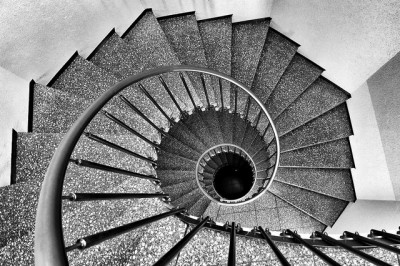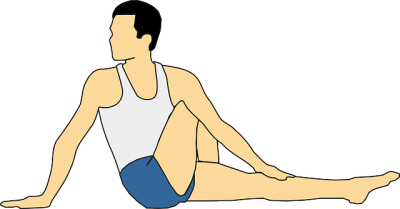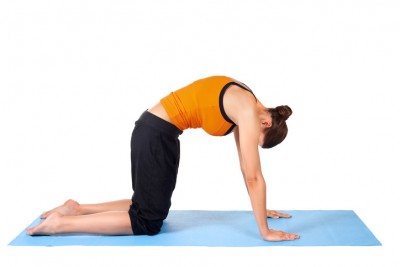There are hundreds of ways to “fall” (i.e. get to the floor) in modern or contemporary dance techniques and choreography. One of the most basic and frequently performed, however, is a controlled spiral to the floor.

I teach this spiral, tuck and roll movement all the time in my own modern dance classes because even first-time dancers pick it up quickly with proper introduction and because it is a “safe” and controlled way to quickly and smoothly get to the floor.
Oddly, I’ve found its explanation has been neglected online… until now! For beginners or those new to floor work in dance, I’ll break down and help you troubleshoot this spiraling roll to the floor.
The Spiral Roll
To keep things simple, I call the movement I’m about to explain a “spiral roll”. Contemporary dance terminology is often inconsistent so if this movement has an alternative name in your corner of the dance world, I’d love to hear about it in the comments!
A spiral roll…
- Begins with a lunge to the front or side.
- This is followed by a spiral of the torso initiating from the pelvis…
- That causes the back (non-lunging) leg to “tuck,” or rotate inward and fold…
- Which brings the dancer to the floor in a seated roll over the posterior (backside) pelvis or sacrum…
- During which the head and knees come close together and the legs “unwind”…
- And allow the dancer to continue in any number of ways, including to spiral upward in another rotation or simply stand with weight on the opposite foot.
For beginners practicing this roll, I often use the ascending spiral to set my students up to repeat another lunge, spiral, and roll. This can be done over and over across the floor if the dancer completes one more rotation as s/he stands and then leads with the same lunging leg each time. When crossing from the other side, I have students lead with the other leg. Here’s a quick montage of a student demonstrating spiral roll repetitions:
In the class exercise by Lorienne Beals below, you can get a good look at the inward rotation of the back leg that folds the legs. The spiral action in this example does not continue – the dancer just rises to a standing position.
Fundamentals First
As with almost any dance step, this one can be broken down to its most fundamental movements and practiced for better understanding.
There are students who innately understand the spiral roll even if they’ve never seen or done it before. If you are struggling with any part of the spiral roll feel free to try the following elemental movements on your own or with guidance from your teacher:
Spiraling the torso
Seated – A familiar way to practice spiraling is with a seated twist. We see variations of such spirals often in yoga practice. Twists, or spirals are a great addition to any warm-up.

Lying down – Human beings first practice spiraling lying down. Infants, yet unable to walk but whose vision and grasp have greatly improved since birth, begin to reach for nearby objects. Their head turns toward the eyes, the opposite fingers reach toward the object, and suddenly a baby rolls over for the first of many times. These contralateral spiraling movements are reproduced in Bartenieff’s fundamental exercises and are very useful to the modern dancer.
Standing – The standing spiral is most directly related to the spiral roll. In a wide second position, starting with one hip, begin a spiraling motion that twists the torso sequentially through to the cervical spine and includes the visual focus. The initiating hip causes the same leg to inwardly rotate. Observing this feeling of spiral while stationary will be key in helping dancers understand the direction and initiation of the roll.
Head-Tail Connection
The relationship between the distal ends of the spine is also elemental in this roll. Dancers can learn to establish this connection by practicing flexion and extension of the spine.
On the knees – Some teachers use animal imagery to help children fine their head-tail connection. Looking at the belly button while arching the back might be a cat or a camel. Sinking the belly button toward the floor while the head and tail reach to the sky could be a puppy or a cow.

(c) rognar www.fotosearch.com Stock Photography
Standing – Dancers can also practice this head-tail connection while standing.
Common mistakes
As I’ve noted, for some students the mechanics of this roll come easily. For others, there are common mistakes made when a beginner tries a spiral roll for the first time. Below are the ones I see most frequently.
Landing on the knee. As you fold the legs under you, avoid coming down on the knee as you would in a kneel. Instead, aim for the side of knee/lower thigh. How to correct it: Practice the standing spiral and remember that feeling of crossing in the upper, inner thighs.
Spiraling to the toes. Beginners sometimes start their twist in the upper body instead of initiating with the hip. The legs do not fold correctly and the dancer crouches and tries to spin on the toes instead of bringing the pelvis to the floor. How to correct it: Practice the standing spiral and focus on the hip initiation. Do it each time with a wider stance that brings you closer to the ground – you’ll see, you don’t need to involve the feet.
Keeping the spine erect. Many beginners understand the spiral that gets them to the floor but they forget to curve the spine. The spiral roll flows more smoothly if you create a ball-like shape with your body. How to correct it: Practice bringing the head and the tail closer together as soon the spiral and folding of the legs begins – don’t wait until you are already sitting on the floor to think about the spine.
Not following through. Transitioning from this roll can be the most challenging part for beginners. Don’t “pull the plug” as soon as the roll is complete. How to correct it: Follow through with the momentum and direction you’ve established from the beginning to flow into whatever is next. Once you’ve got the spiral roll itself, practice it with special focus on how you unfold – if possible, continue the spiral or rotation and concentrate on uncoiling the spine.
Hopefully this breakdown helps you master the spiral roll. If you missed it, we’ve also covered another fundamental contemporary dance movement, the spinal roll-down, as well as other steps and basic technique.
What are some others you’d like to see broken down?
Nichelle Suzanne is a writer specializing in dance and online content. She is also a dance instructor with over 20 years experience teaching in dance studios, community programs, and colleges. She began Dance Advantage in 2008, equipped with a passion for movement education and an intuitive sense that a blog could bring dancers together. As a Houston-based dance writer, Nichelle covers dance performance for Dance Source Houston, Arts+Culture Texas, and other publications. She is a leader in social media within the dance community and has presented on blogging for dance organizations, including Dance/USA. Nichelle provides web consulting and writing services for dancers, dance schools and studios, and those beyond the dance world. Read Nichelle’s posts.

